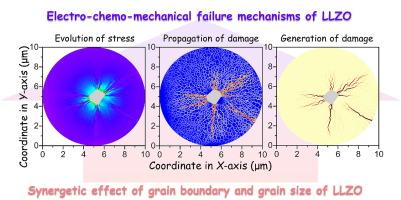解耦固态电解质晶界强度和晶粒尺寸隐蔽性在晶粒级电化学机械破坏中的作用
IF 14.9
1区 化学
Q1 Energy
引用次数: 0
摘要
石榴石锂镧锆氧化物(Li7La3Zr2O12,LLZO)是一种基准固态电解质(SSE)材料,因其对金属锂具有高导电性和化学稳定性而受到广泛关注。尽管对其电化学机械失效机制进行了大量研究,但对 LLZO 晶界强度和晶粒大小的作用仍未充分探讨,这阻碍了其性能的进一步提高。在此,我们结合电化学动力学和内聚区模型,解耦了多晶 LLZO 的晶粒尺寸和晶界强度的影响。我们发现,LLZO 的解体是由局部位移的累积开始的,这与晶粒尺寸和晶界强度的变化密切相关。然而,晶界强度的变化会影响损伤的扩散和传播途径,而 LLZO 的破坏则由晶粒大小决定。大的 LLZO 晶粒有利于在低晶界强度下发生跨晶粒损伤,这会改变 LLZO 块体内部的局部化学力学,导致更广泛的损伤传播。研究结果展示了通过优先控制锂枝晶在晶界的生长及其在石榴石型 SSE 中的穿透来优化结构的途径。本文章由计算机程序翻译,如有差异,请以英文原文为准。

Decoupling the roles of grain boundary strength and grain size hidden in grain-level electro-chemo-mechanical failure of solid-state electrolyte
Garnet lithium lanthanum zirconium oxide (Li7La3Zr2O12, LLZO) is a benchmark solid-state electrolyte (SSE) material receiving considerable attention owing to its high conductivity and chemical stability against Li metal. Although its electro-chemo-mechanical failure mechanisms have been much investigated, the equivocal roles of grain boundary strength and grain size of LLZO remain under-explored, hindering further performance improvements. Here we decoupled the effects of grain size and grain boundary strength of polycrystalline LLZO via the combination of electrochemical kinetics and the cohesive zone model. We discovered that the disintegration of LLZO is initiated by the accumulation of local displacements, which strongly relates to the changes in both grain size and grain boundary strength. However, variations in grain boundary strength affect the diffusion and propagation pathways of damage, while the failure of LLZO is determined by the grain size. Large LLZO grains facilitate transgranular damage under low grain boundary strength, which can alter local chemo-mechanics within the bulk of LLZO, leading to more extensive damage propagation. The results showcase the structure optimization pathways by preferentially controlling the growth of lithium dendrites at grain boundaries and their penetration in garnet-type SSE.
求助全文
通过发布文献求助,成功后即可免费获取论文全文。
去求助
来源期刊

Journal of Energy Chemistry
CHEMISTRY, APPLIED-CHEMISTRY, PHYSICAL
CiteScore
19.10
自引率
8.40%
发文量
3631
审稿时长
15 days
期刊介绍:
The Journal of Energy Chemistry, the official publication of Science Press and the Dalian Institute of Chemical Physics, Chinese Academy of Sciences, serves as a platform for reporting creative research and innovative applications in energy chemistry. It mainly reports on creative researches and innovative applications of chemical conversions of fossil energy, carbon dioxide, electrochemical energy and hydrogen energy, as well as the conversions of biomass and solar energy related with chemical issues to promote academic exchanges in the field of energy chemistry and to accelerate the exploration, research and development of energy science and technologies.
This journal focuses on original research papers covering various topics within energy chemistry worldwide, including:
Optimized utilization of fossil energy
Hydrogen energy
Conversion and storage of electrochemical energy
Capture, storage, and chemical conversion of carbon dioxide
Materials and nanotechnologies for energy conversion and storage
Chemistry in biomass conversion
Chemistry in the utilization of solar energy
 求助内容:
求助内容: 应助结果提醒方式:
应助结果提醒方式:


